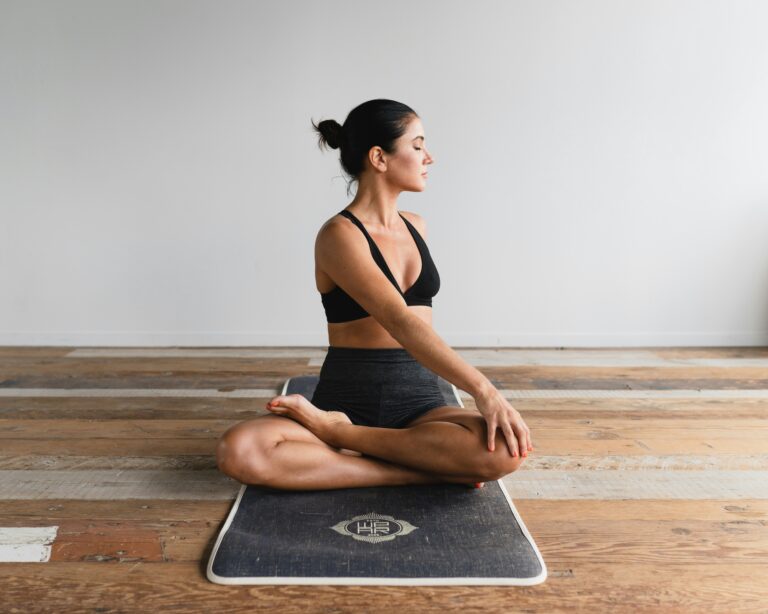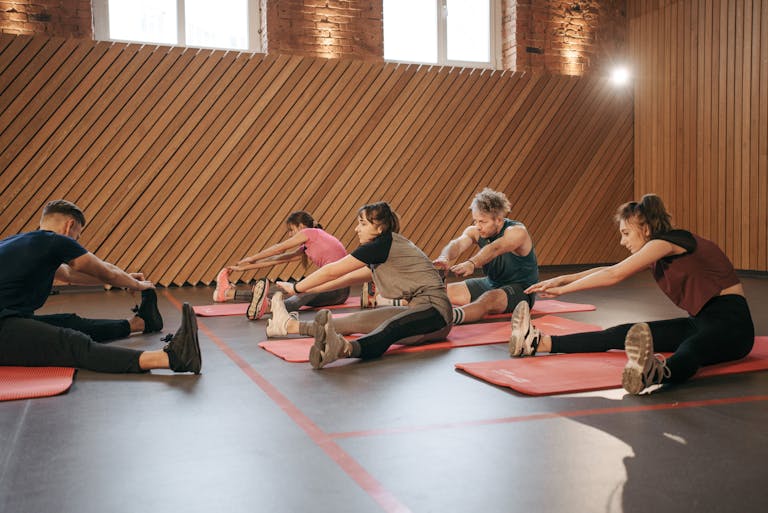Chronic pain affects almost 50 million adults in the US, with neck, lower back and hip pain being top complaints. Here’s the good news: targeted stretching can reduce muscular pain by up to 40% when done consistently, according to a study in the Journal of Physical Therapy Science.
If you have daily aches from desk work, poor posture or an active lifestyle, this guide has got you covered. Stretching isn’t just about flexibility – it’s a powerful tool for pain management that you can use anywhere, anytime.
This guide will take you through science-backed stretching techniques for 3 major pain areas: neck, lower back and hips, as well as upper body flexibility and tension relief. You’ll learn step-by-step instructions for beginner-friendly stretches, why they work and how to build a daily routine. Whether you have tech neck from hours at your computer or tight hips from sitting too much, these targeted stretches can help you find relief.
Why Stretching Is a Game-Changer for Pain Relief
Stretching addresses the root causes of muscular pain through several physiological mechanisms. When muscles are in shortened positions for extended periods, they develop trigger points and adhesions that restrict movement and cause pain.
Regular stretching increases blood flow to affected areas, delivering oxygen and nutrients while removing metabolic waste products that cause soreness. This increased circulation helps break up muscle knots and reduce inflammation around joints.
Stretching also activates the parasympathetic nervous system, which promotes relaxation and reduces the body’s stress response. This is especially important for pain management as stress and tension often create a cycle where pain causes muscle tightness, increasing pain levels.
The benefits go beyond immediate pain relief. Consistent stretching improves joint mobility, corrects muscle imbalances and improves posture. Stretching after exercise helps muscles relax and recover and reduces the risk of injury. These changes help prevent future injuries and reduce the likelihood of chronic pain in other parts of your body.
Most importantly, stretching is for everyone. Unlike other pain management strategies that require special equipment or professional treatment, effective stretching can be done at home with just a few minutes of your time.
Neck Pain Relief Stretches
Neck Pain Causes
Neck pain has become more common due to our technology-dependent lifestyle. “Tech neck” occurs when we crane our heads forward to look at screens, putting excessive strain on the cervical spine. Every inch your head moves forward from its neutral position doubles the weight your neck muscles must support.
Poor sleeping posture, sudden movements, and prolonged sitting contribute to neck discomfort. Stress compounds these issues by causing unconscious muscle tension in the neck and shoulders.
Targeted Neck Stretches
Chin Tucks
This exercise strengthens deep neck muscles while stretching tight posterior muscles. Sit or stand with your shoulders relaxed. Gently tuck your chin back as if creating a double chin, keeping your head level. Hold for 5 seconds and repeat 10 times. This stretch helps counteract forward head posture.
Ear-to-Shoulder Stretch
Sit tall and slowly tilt your right ear towards your right shoulder without lifting the shoulder. Place your right hand gently on the left side of your head for a deeper stretch. Hold for 30 seconds and repeat on the other side. This targets the upper trapezius and levator scapulae muscles.
Upper Trap Stretch
Sit in a chair and grip the seat with your left hand. Tilt your head to the right and slightly forward. Use your right hand to pull your head further into the stretch gently. For added benefit, gently squeeze your shoulder blades together to enhance the stretch and improve posture. Hold for 30 seconds per side. This stretch is great for shoulder and neck tension.
Start with gentle pressure and gradually increase intensity as your muscles adapt. Never force a stretch to the point of sharp pain.
A triceps stretch can also help with neck, shoulders, and upper body tension.
Lower Back Pain Relief Stretches
Lower Back Pain Causes
Lower back pain affects up to 80% of adults at some point in their lives. Sedentary behavior weakens the core muscles that support your spine, while tight hip flexors from sitting too much pull on the lower back. Poor lifting mechanics and inadequate warm-up before physical activity also contribute to lumbar spine problems.
Modern work environments often involve prolonged sitting in non-ergonomic positions, creating muscle imbalances between tight hip flexors and weak glutes. This combination puts excessive stress on the lower back muscles and spinal joints.
Essential Hamstring Stretch and Lower Back Stretches
Cat-Cow Stretch
Start on your hands and knees, wrists under shoulders and knees under hips. Arch your back while lifting your chest and tailbone for cow pose, then round your spine while tucking your chin and tailbone for cat pose. Move slowly between positions for 10-15 repetitions. This stretch improves spinal mobility and relieves stiffness.
Child’s Pose
Kneel on the floor with big toes touching and knees hip-width apart. Sit back on your heels and fold forward, extending your arms in front of you or alongside your body. Hold for 30-60 seconds. This gentle stretch lengthens the lower back muscles and promotes relaxation.
Knee-to-Chest Stretch
Lie on your back and pull one knee toward your chest, keeping the other leg straight. For additional comfort or support, you can keep the opposite leg with a bent knee. Hold for 30 seconds and switch sides. This stretch targets the lower back, glutes, and hip flexors while promoting spinal decompression.
Seated Forward Fold
Sit with your legs extended and slowly fold forward from your hips, reaching toward your toes. Keep your knees slightly bent to protect your lower back and make the stretch more accessible. Keep your back straight rather than rounding your spine. Hold for 30-45 seconds. This stretch lengthens the entire posterior chain while gently decompressing the lumbar spine.
Hip Pain Relief Stretches
Hip Pain Causes
Tight hip flexors are an epidemic in our sitting-dominant culture. When hip flexors remain shortened for hours, they pull on the lower back and create compensatory patterns throughout the body. Weak glutes compound this problem by failing to provide adequate stability and support.
Hip pain can also result from overuse in active individuals, particularly runners and cyclists who perform repetitive hip flexion movements. Poor movement patterns during exercise can create imbalances between different muscle groups around the hip joint.
Best Hip Stretches for Pain Relief
Figure Four Stretch
Lie on your back with both knees bent and feet flat on the floor. Place your right ankle on your left thigh just above the knee. Thread your hands behind your left thigh (the opposite leg) and gently pull toward your chest. Hold for 30 seconds per side. This stretch targets the piriformis and deep hip rotator muscles, with the opposite leg stretched.
Lunge
Step into a lunge with your left foot forward. Lower your right back knee to the ground and push your hips forward while keeping your torso upright. You should feel the stretch in the front of your right hip. To adjust the intensity, the back leg can remain straight or slightly bent. Hold for 30 seconds and switch sides. This stretch targets tight hip flexors.
90/90 Hip Stretch
Sit with your right leg bent at 90 degrees in front of you and your left leg to the side, also bent at 90 degrees. You may bend the back knee slightly for comfort or to deepen the stretch. Lean forward over your front leg to stretch the hip flexors, then lean toward your back leg to stretch the glutes. Hold each position for 30 seconds before switching sides.
Pigeon Pose
Bring your right knee forward from your hands and knees and place it behind your right wrist. Extend your left leg straight back. Lower down onto your forearms, or rest your forehead on your hands. Hold for 60 seconds per side. This deep hip opener stretches multiple muscle groups simultaneously.
Flexibility Exercises for Pain Relief
Flexibility exercises are key to pain relief, easing tight muscles and improving range of motion. You can relieve discomfort in the lower leg, thighs, shoulders, and more by targeting specific areas. For example, a calf stretch is excellent for lower leg tension. Stand facing a wall, place your hands at arm’s length, and step one leg back, keeping your heel flat on the floor and your knee straight. Hold for 30 seconds, then switch legs.
A hamstring stretch can help with back of thigh pain. Sit on the floor with one leg extended and the other knee bent, then gently reach toward your toes, keeping your back straight. Hold for 30 seconds and switch legs.
To do a quadriceps stretch, stand with one hand against a wall for balance. Bend one knee and bring your heel toward your glutes, holding your ankle with your hand. Keep your knees together and your thigh straight with your body. Hold for 30 seconds, then switch legs.
For a simple shoulder stretch, bring one arm across your chest and gently pull it closer with your opposite hand, feeling a stretch across your shoulder. Hold for 30 seconds, then switch arms. See a physical therapist if you’re unsure which flexibility exercises are best for you. They can recommend stretches for your specific pain points and help you create a safe stretching program.
Static Stretching
Static stretching is a powerful way to increase flexibility and release muscle tension. It involves holding a stretch for 20-30 seconds and allowing your muscles to relax and lengthen gradually. To start, stand with your feet shoulder-width apart and slowly bend to one side, keeping your arm straight up. Hold the stretch, then switch sides to ensure both sides of your body benefit.
You can use static stretching for various muscle groups. For example, kneel on one knee with your other foot forward to target your hip flexors, forming a 90-degree angle. Keep your back straight and lean forward until you feel a stretch in the front of your hip. Hold, then switch legs.
Static stretching is best done after warming up your muscles, such as after a workout or a short walk. Incorporating static stretching into your routine will help your muscles recover, loosen up, and support long-term flexibility.
Stretching Safely and Effectively
Follow these best practices to get the most out of your stretching program and avoid injury. Always warm up—light cardio or dynamic stretching will get blood flowing to your muscles, making them more pliable and less prone to strain.
Start each stretch gently and gradually increase the intensity as your muscles adapt. Never force a stretch or push through pain; mild discomfort is normal, but pain is a sign to stop. Make sure to stretch all major muscle groups, including your neck, shoulders, back, hips, and legs, to maintain overall balance and flexibility.
For example, to stretch your neck, slowly tilt your head to one side, bring your ear towards your shoulder, and hold for 30 seconds. Switch sides to make sure you stretch evenly.
Remember, consistency is key. Regular and safe stretching will give you the best results and keep your muscles healthy and pain-free.
Common Mistakes to Avoid When Stretching
Avoid these common mistakes to maximize the benefits of your stretching routine and prevent injury. One big mistake is bouncing or forcing your body beyond a comfortable range of motion, leading to muscle strains or joint pain. Instead, use slow and controlled movements and hold each stretch steady. Another mistake is not holding stretches long enough—aim for at least 20-30 seconds to let your muscles relax fully. Stretching cold muscles is risky, so always warm up before you start.
Don’t forget to breathe naturally and smoothly throughout each stretch; holding your breath can increase tension and reduce the effectiveness of the stretch. For example, when doing a knee-to-chest stretch, lie on your back, bring one knee towards your chest, hold for 30 seconds, and breathe deeply. Switch legs to make sure both sides are stretched evenly.
Avoid these traps, and your stretching will be safer and more effective.
Stretching for Mobility
Stretching daily is a powerful way to increase mobility and reduce your risk of injury. Regular stretching increases your range of motion, eases muscle tightness, and supports overall flexibility. Simple stretches like standing hamstring or seated shoulder stretches can greatly affect how your body feels and moves.
To stretch your inner thigh, sit on the floor with your knees bent and feet together. Hold your feet with your hands and lean forward, feeling a stretch in your inner thighs. Hold for 30 seconds, then relax and repeat as needed.
Listen to your body—stop and reassess your form if you feel pain. For personalized guidance, see a physical therapist who can recommend stretches for your specific needs and help you progress safely.
By stretching daily, you’ll have more mobility, less discomfort, and a more active, pain-free life.
How to Create a Daily Stretching Routine
Consistency is more important than duration when stretching for pain relief. Aim for 10-15 minutes of focused stretching daily rather than longer, less frequent sessions. Your muscles respond better to regular gentle stretching than sporadic intense sessions.
Morning stretching helps counteract stiffness from sleeping and prepares your body for daily activities. Evening stretching helps release accumulated tension and improve sleep. Choose a time that fits your schedule.
15-Minute Pain Relief Routine:
- Chin tucks (2 minutes)
- Ear-to-shoulder stretches (2 minutes)
- Cat-cow stretch (3 minutes)
- Child’s pose (2 minutes)
- Hip flexor stretches (3 minutes)
- Figure four stretch (3 minutes): Many stretches start with standing with your feet shoulder-width apart for better alignment and stability. For wall stretches, stand at arm’s length from the wall to ensure proper form and effectiveness.
Set reminders on your phone or use fitness apps to stay consistent. Track your progress by noting your pain levels before and after stretching. Many people notice improvements in 1-2 weeks of regular practice.
Listen to your body and adjust intensity based on how you feel each day. Some discomfort is normal, but sharp pain means you should back off or see a healthcare provider.
Start Your Pain-Free Life
Targeted stretching is a simple yet powerful way to manage neck, lower back, and hip pain. This guide’s stretches address the most common areas of pain and require no special equipment or time commitment.
Remember, consistency trumps intensity. Ten to fifteen minutes daily can greatly affect your pain levels and mobility. Start with the stretches that apply to your specific pain areas, then add others as you become more flexible.
Pain doesn’t have to be your constant companion. These evidence-based stretching techniques can help you regain comfort and mobility in your daily life. Bookmark this guide and share with friends or family members who could benefit from natural pain relief methods.
Ready to take your wellness to the next level? Explore our expert-curated stretching programs designed for you. Our personalized approach combines targeted exercises with community support to help you achieve lasting pain relief and a better living.
Medical Disclaimer:
This content is for informational purposes only and is not intended as medical advice, diagnosis, or treatment. Always consult with a qualified healthcare professional before making any changes to your diet, exercise, or health routine. Never disregard professional medical advice or delay seeking it because of something you have read on this site.





